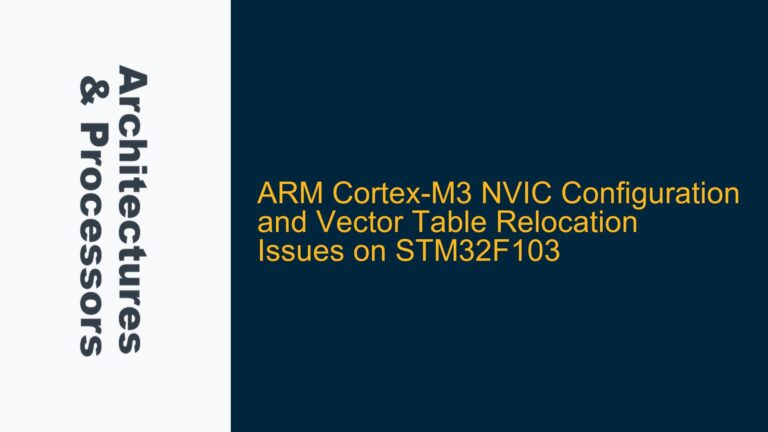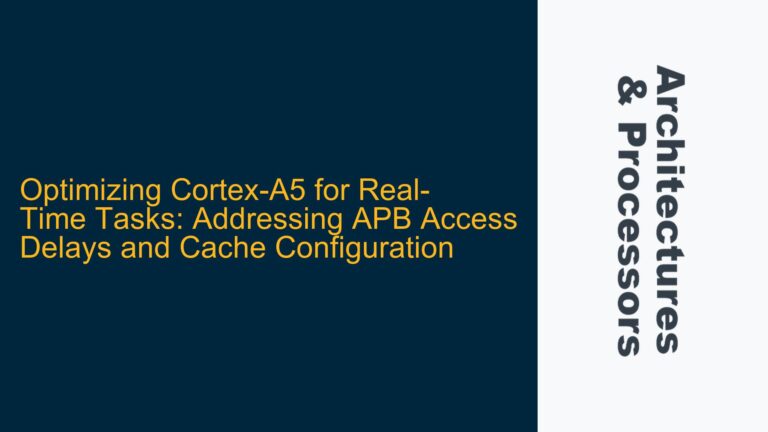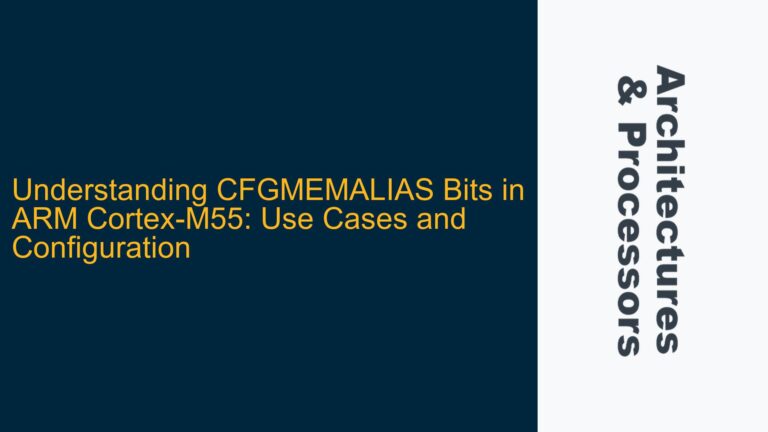ARM Cortex-R5 PC Value Corruption in Wave Simulation
The issue at hand involves the Program Counter (PC) value of an ARM Cortex-R5 core becoming undefined (represented as ‘X’) during wave simulation, while the same firmware runs correctly on an FPGA. This discrepancy suggests a simulation-specific problem rather than a fundamental hardware or firmware flaw. The Cortex-R5 core operates in Thumb mode, while the Cortex-R8 core operates in ARM mode, and both cores share identical build flags (CFLAGS, assembly flags, and linker flags). The problem manifests only in the simulation environment, indicating a potential mismatch between the simulation setup and the actual hardware behavior.
The Cortex-R5 core’s PC value corruption could stem from several factors, including simulation model inaccuracies, improper initialization sequences, or timing-related issues in the simulation environment. The fact that the firmware runs correctly on the FPGA suggests that the issue is not related to the firmware itself but rather to how the simulation environment models the Cortex-R5 core’s behavior. This discrepancy is critical to resolve, as simulation is a key tool for debugging and validating embedded systems before deployment.
Simulation Model Inaccuracies and Thumb Mode Handling
One of the primary causes of the Cortex-R5 PC value becoming ‘X’ in the wave simulation is the potential inaccuracy of the simulation model in handling Thumb mode execution. The Cortex-R5 core operates in Thumb mode, which uses 16-bit instructions instead of the 32-bit instructions used in ARM mode. Simulation models may not always accurately replicate the behavior of Thumb mode execution, especially when transitioning between ARM and Thumb modes or during exception handling.
Another possible cause is the initialization sequence of the Cortex-R5 core in the simulation environment. The simulation may not correctly initialize the core’s state, leading to undefined behavior in the PC value. This could include improper handling of the reset vector, stack pointer initialization, or mode switching during the boot process. Additionally, timing discrepancies in the simulation environment could cause the Cortex-R5 core to behave differently compared to the FPGA implementation, leading to the PC value corruption.
The use of identical build flags for both cores may also contribute to the issue. While the Cortex-R8 core operates in ARM mode and the Cortex-R5 core operates in Thumb mode, the build flags may not account for the differences in instruction sets and execution modes. This could result in the simulation environment misinterpreting the Cortex-R5 core’s behavior, leading to the PC value becoming ‘X’.
Resolving Simulation-Specific PC Value Corruption
To address the Cortex-R5 PC value corruption in the wave simulation, the first step is to verify the accuracy of the simulation model. This involves ensuring that the simulation model correctly supports Thumb mode execution and accurately replicates the behavior of the Cortex-R5 core. If the simulation model is found to be inaccurate, it may be necessary to update or replace the model with one that correctly handles Thumb mode execution.
Next, the initialization sequence of the Cortex-R5 core in the simulation environment should be carefully reviewed. This includes verifying that the reset vector, stack pointer, and mode switching are correctly handled during the boot process. Any discrepancies in the initialization sequence should be corrected to ensure that the Cortex-R5 core starts in a valid state. Additionally, the simulation environment’s timing should be compared to the FPGA implementation to identify and resolve any timing-related issues.
The build flags used for the Cortex-R5 core should also be reviewed to ensure that they are appropriate for Thumb mode execution. This may involve adding or modifying flags to account for the differences in instruction sets and execution modes between the Cortex-R5 and Cortex-R8 cores. For example, the -mthumb flag should be used to ensure that the compiler generates Thumb mode instructions for the Cortex-R5 core.
Finally, it is important to validate the simulation environment’s behavior against the FPGA implementation. This can be done by running the same firmware on both the simulation and the FPGA and comparing the results. Any discrepancies should be investigated and resolved to ensure that the simulation environment accurately replicates the behavior of the Cortex-R5 core.
By following these steps, the issue of the Cortex-R5 PC value becoming ‘X’ in the wave simulation can be resolved, ensuring that the simulation environment accurately replicates the behavior of the Cortex-R5 core and provides a reliable platform for debugging and validating the firmware.
Detailed Analysis of Simulation Model Inaccuracies
The simulation model’s accuracy is critical for replicating the behavior of the Cortex-R5 core, especially in Thumb mode. Thumb mode uses 16-bit instructions, which can lead to different execution patterns compared to ARM mode. If the simulation model does not correctly handle Thumb mode execution, it may misinterpret instructions or fail to correctly update the PC value, leading to the ‘X’ state.
To verify the simulation model’s accuracy, the following steps should be taken:
-
Review the Simulation Model Documentation: Ensure that the simulation model explicitly supports Thumb mode execution. The documentation should provide details on how Thumb mode instructions are handled and any limitations or known issues.
-
Compare Instruction Execution: Run a series of test cases on both the simulation and the FPGA, focusing on Thumb mode instructions. Compare the results to identify any discrepancies in instruction execution or PC value updates.
-
Check Exception Handling: Thumb mode exception handling can differ from ARM mode. Verify that the simulation model correctly handles exceptions, including interrupt handling and mode switching, during Thumb mode execution.
-
Validate Branch and Jump Instructions: Thumb mode branch and jump instructions may have different addressing modes compared to ARM mode. Ensure that the simulation model correctly handles these instructions and updates the PC value accordingly.
If the simulation model is found to be inaccurate, it may be necessary to update or replace the model. This could involve working with the simulation tool vendor to obtain an updated model or switching to a different simulation tool that provides better support for Thumb mode execution.
Initialization Sequence Review and Correction
The initialization sequence of the Cortex-R5 core is critical for ensuring that the core starts in a valid state. Any errors in the initialization sequence can lead to undefined behavior, including the PC value becoming ‘X’. The following steps should be taken to review and correct the initialization sequence:
-
Verify Reset Vector: Ensure that the reset vector correctly points to the start of the Thumb mode code. The reset vector should be set to the address of the Thumb mode entry point, with the least significant bit set to 1 to indicate Thumb mode.
-
Check Stack Pointer Initialization: The stack pointer should be initialized to a valid memory region before any function calls or exception handling occurs. Verify that the stack pointer is correctly initialized in the simulation environment.
-
Review Mode Switching: During the boot process, the Cortex-R5 core may switch between different modes (e.g., ARM mode to Thumb mode). Ensure that the simulation environment correctly handles these mode switches and updates the PC value accordingly.
-
Validate Memory Initialization: The memory regions used by the Cortex-R5 core should be correctly initialized before the core starts executing code. This includes the code, data, and stack memory regions. Verify that the simulation environment correctly initializes these memory regions.
Any discrepancies in the initialization sequence should be corrected to ensure that the Cortex-R5 core starts in a valid state. This may involve modifying the boot code or the simulation environment’s configuration.
Timing Discrepancies and Simulation Environment Validation
Timing discrepancies between the simulation environment and the FPGA implementation can lead to differences in behavior, including the PC value becoming ‘X’. To identify and resolve timing-related issues, the following steps should be taken:
-
Compare Clock Frequencies: Ensure that the clock frequencies used in the simulation environment match those used in the FPGA implementation. Any differences in clock frequencies can lead to timing discrepancies.
-
Validate Timing Constraints: Verify that the simulation environment correctly enforces timing constraints, including memory access times and peripheral response times. Any violations of timing constraints should be investigated and resolved.
-
Check Synchronization Mechanisms: If the Cortex-R5 core interacts with other cores or peripherals, ensure that the simulation environment correctly models synchronization mechanisms, such as semaphores or interrupts. Any discrepancies in synchronization can lead to timing-related issues.
-
Run Timing Analysis: Use timing analysis tools to compare the timing behavior of the simulation environment and the FPGA implementation. Identify any differences and resolve them to ensure that the simulation environment accurately replicates the timing behavior of the Cortex-R5 core.
By addressing timing discrepancies, the simulation environment can be made to more accurately replicate the behavior of the Cortex-R5 core, reducing the likelihood of the PC value becoming ‘X’.
Build Flag Review and Modification
The build flags used for the Cortex-R5 core should be reviewed to ensure that they are appropriate for Thumb mode execution. The following steps should be taken:
-
Verify Thumb Mode Flag: Ensure that the
-mthumbflag is used when compiling code for the Cortex-R5 core. This flag instructs the compiler to generate Thumb mode instructions. -
Check Optimization Flags: Optimization flags can affect the generated code, including the handling of Thumb mode instructions. Verify that the optimization flags used for the Cortex-R5 core are appropriate for Thumb mode execution.
-
Review Linker Script: The linker script should be reviewed to ensure that it correctly handles Thumb mode code. This includes ensuring that the code sections are correctly aligned and that the entry point is set to the Thumb mode entry point.
-
Validate Debug Information: Debug information can be useful for diagnosing issues in the simulation environment. Ensure that the build flags include debug information, such as
-g, to facilitate debugging.
By reviewing and modifying the build flags, the compiler and linker can be configured to correctly generate and link Thumb mode code for the Cortex-R5 core, reducing the likelihood of the PC value becoming ‘X’.
Conclusion
The issue of the Cortex-R5 PC value becoming ‘X’ in the wave simulation is a complex problem that requires a thorough analysis of the simulation environment, initialization sequence, timing behavior, and build flags. By following the steps outlined in this guide, the issue can be resolved, ensuring that the simulation environment accurately replicates the behavior of the Cortex-R5 core and provides a reliable platform for debugging and validating the firmware.






